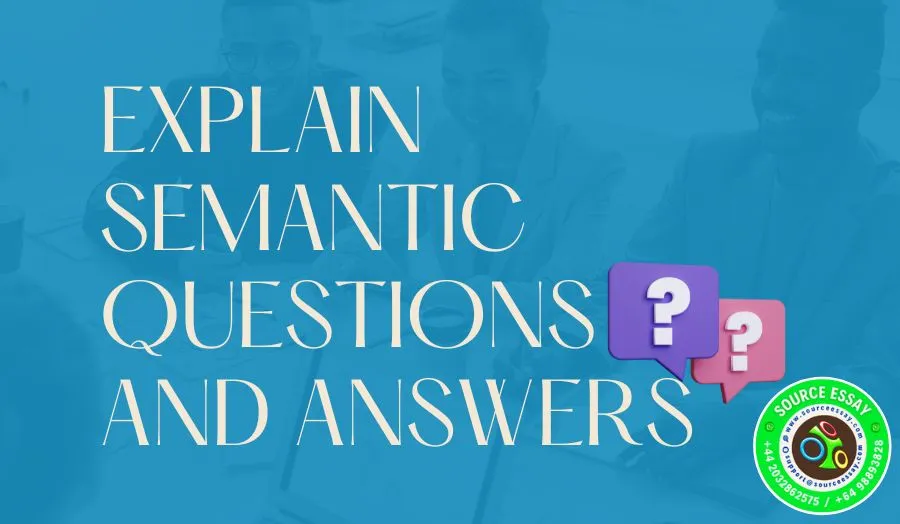Introduction
Inquiries about the connections and links between ideas are examples of semantic inquiry. Semantic responses, on the other hand, go to the heart of the matter by addressing the fundamental significance of the query in a way that makes sense in the given context. In the following sections, there will be a discussion about the overview, obstacles, and conclusion.
Overview
Information search, answering questions infrastructure, conversation systems, as well as virtual assistants are just a few of the many fields that benefit greatly from semantic inquiries and responses (Abdelaziz et al., 2021). For efficient interaction between humans and machines and the facilitation of acquiring information, it is crucial that computers can properly grasp semantic inquiries and offer appropriate replies.
Obstacles
Ambiguity
Because of the vague nature of natural language, law dissertation help Birmingham and the answers to semantic inquiries may also be unclear. Polysemy (words having many meanings) and homology (words with comparable spelling or sound) are two sources of ambiguity. Inaccurate or deceptive replies may result from the difficulty of resolving ambiguity and correctly comprehending the intended purpose of a question.
Relevance to Context
Often, the setting in which a question is posed determines its significance. It’s possible that more background knowledge is needed to fully understand and answer a question with a semantic component (Li et al., 2021). There is a higher chance of giving inaccurate or partial replies without the appropriate context, Source Essay provide help of online assignment help uk.
Improper Accuracy
It’s not uncommon for semantic inquiries to lack precision or detail. Questions that lack clarity or specificity hinder the generation of useful replies. It’s possible that further questions or clarifications may be needed to get a good answer.
Barriers to Knowledge
The ability to query appropriate databases or information sources is essential for semantic question answering. The length and breadth of the foundational data determine how precise and comprehensive the results will be (Xu et al., 2021). Incorrect or inadequate responses may result from using data that is either out of date or incomplete.
Inference and Reasoning
The proper response to certain semantic problems can only be arrived by the help of dissertation writing service uk and via inference and reasoning. These inquiries are frequently beyond the scope of a standard information search due to the complexity of the logical or conceptual linkages involved (Xie et al., 2021). One of the biggest obstacles in the field of “semantic question answering” is the creation of reliable algorithms and models capable of complex reasoning and inference.
Conclusion
Understanding natural language technologies rely heavily on semantic inquiries and replies for efficient communication and information acquisition. They have a lot of promise, but there are also certain problems that require fixing. Problems arise in correctly comprehending and answering meaningful questions due to ambiguity, context dependence, lack of accuracy, knowledge constraints, and the requirement for reasoning through inference. Significant progress has been made in semantic question answering as a result of developments in NLP and ML approaches. To make “semantic question answering systems” more reliable and accurate, researchers are looking into new methods like models for deep learning with massive knowledge networks.
Reference
Abdelaziz, I., Ravishankar, S., Kapanipathi, P., Roukos, S. and Gray, A., 2021, May. A semantic parsing and reasoning-based approach to knowledge base question answering. In Proceedings of the AAAI conference on artificial intelligence (Vol. 35, No. 18, pp. 15985-15987). https://ojs.aaai.org/index.php/AAAI/article/view/17988/17793
Li, Z., Tomar, Y. and Passonneau, R.J., 2021, November. A semantic feature-wise transformation relation network for automatic short answer grading. In Proceedings of the 2021 Conference on Empirical Methods in Natural Language Processing (pp. 6030-6040). https://aclanthology.org/2021.emnlp-main.487.pdf
Xu, W., Zhang, H., Cai, D. and Lam, W., 2021. Dynamic semantic graph construction and reasoning for explainable multi-hop science question answering. arXiv preprint arXiv:2105.11776. https://arxiv.org/pdf/2105.11776
Xie, H., Qin, Z. and Li, G.Y., 2021. Task-oriented multi-user semantic communications for VQA. IEEE Wireless Communications Letters, 11(3), pp.553-557. https://arxiv.org/pdf/2108.07357

